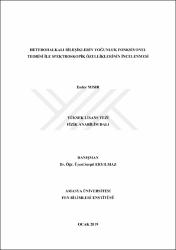Heterohalkalı bileşiklerin yoğunluk fonksiyonel teorisi ile spektroskopik özelliklerinin incelenmesi

View/
xmlui.dri2xhtml.METS-1.0.item-rights
info:eu-repo/semantics/openAccessDate
2019Metadata
Show full item recordAbstract
Bu tez çalışmasında, heterohalkalı gruplar içeren 4-(4-bromofenil)-2-(2-piridinil)tiyazol) ve 4-(2-naftil)-2-(2-piridinil)tiyazol moleküllerinin yapısal özellikleri spektroskopik ve kuramsal yöntemler kullanılarak incelenmiştir. Moleküllerin kristal geometrileri XRD tekniği, spektroskopik karakterizasyonları ise FT-IR ve NMR yöntemleri ile belirlenmiştir. Kuramsal analiz sürecinde; Yoğunluk Fonksiyonel Teorisi (YFT), 6-311G(d,p) ve 6-311++G(d,p) baz setleri kullanılarak moleküler geometri şekillenimleri, titreşim bantları ve kimyasal kayma değerleri gibi spektroskopik parametreleri incelenerek deneysel sonuçlarla birlikte değerlendirilmiştir. Ayrıca moleküllerin sahip oldukları öncü moleküler orbital (HOMO-LUMO) enerjileri, iyonizasyon potansiyeli, elektron ilgisi, kimyasal sertlik ve yumuşaklık gibi birtakım reaktivite parametreleri ve moleküler elektrostatik potansiyel haritaları kuramsal olarak belirlenmiştir. Tüm kuramsal analizler Gaussian 09W paket programı ve GaussView 5.0 arayüz programları kullanılarak gerçekleştirilmiştir. In this thesis study, 4-(4-bromophenyl)-2-(2-pyridinyl)thiazole and 4-(2-naphthyl)-2-(2-pyridinyl)thiazole molecules containing heterocyclic groups were investigated using spectroscopic and theoretical methods. The crystal geometries of the molecules were determined by XRD technique and their spectroscopic characterizations were determined by FT-IR and NMR methods. In the theoretical analysis process, the spectroscopic parameters such as molecular geometry configurations, vibration bands and chemical shift values were investigated by using Density Functional Theory (DFT), 6-311G(d,p) and 6-311++G(d,p) basis sets, and findings were evaluated together with experimental results. In addition, the frontier molecular orbital (HOMO-LUMO) energies, ionization potential, electron affinity, chemical hardness and softness parameters and molecular electrostatic potential maps were determined theoretically. All theoretical analyses were performed using Gaussian 09W package program and GaussView 5.0 interface programs.
URI
https://tez.yok.gov.tr/UlusalTezMerkezi/TezGoster?key=as2oTjW5jfr9IKSvmCdJYoLfgUETeGBzYhdraqYWPrt3vOHFeTxpmSOYrRXVVk_Chttps://hdl.handle.net/20.500.12450/1753
Collections
- Tez Koleksiyonu [397]

















